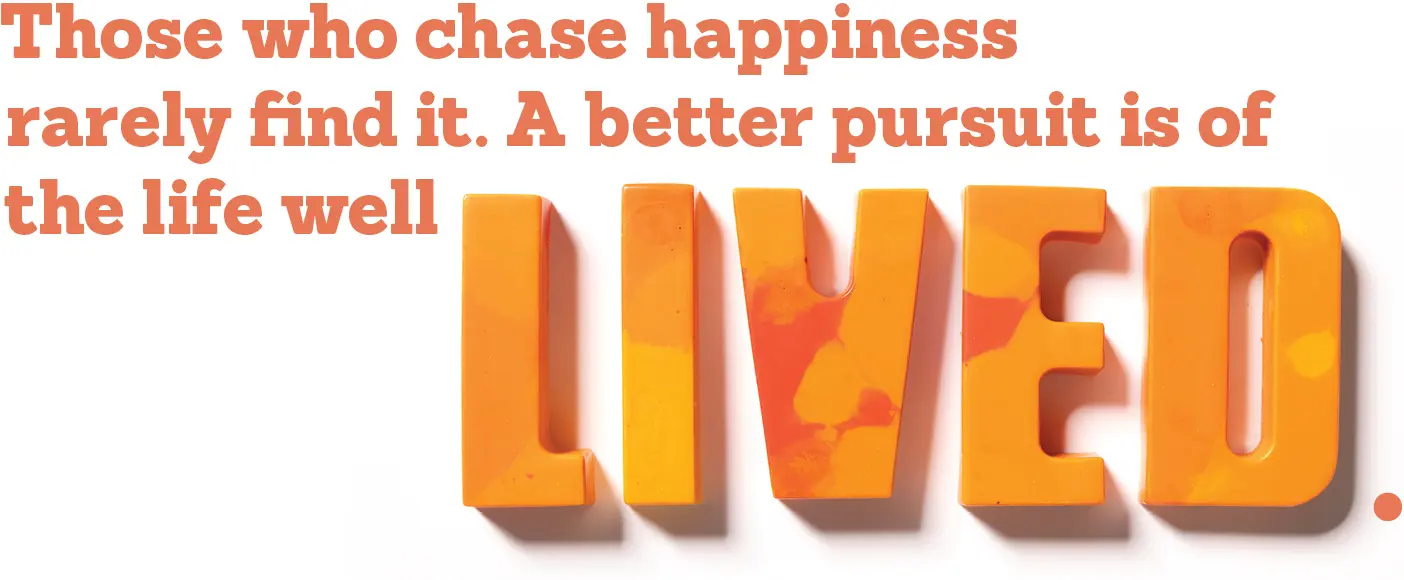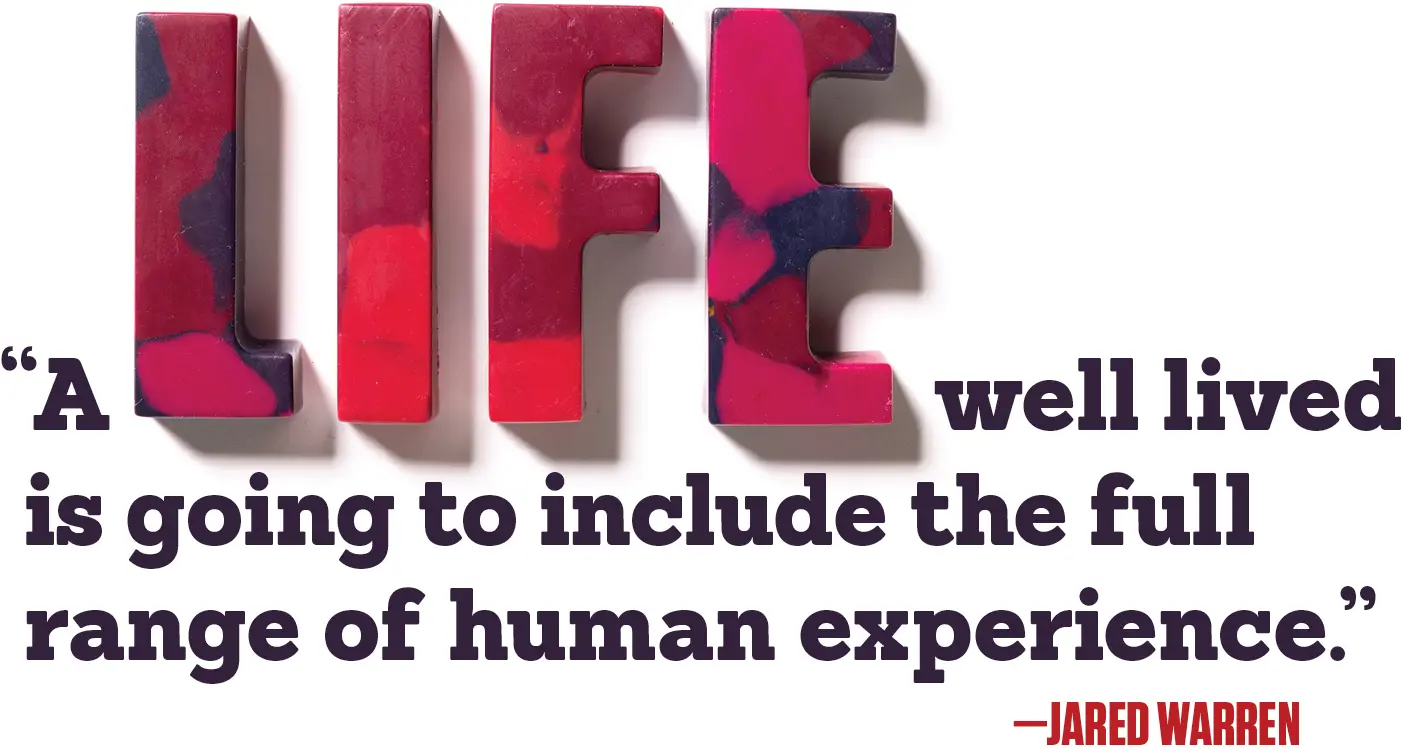Let Joy Find You

Let Joy Find You
Happiness isn’t a destination; it’s something that finds you along the way.
By Emily Smurthwaite Edmonds (BA ’01, MA ’04) in the Winter 2023 issue
Illustrations by Red Nose Studio
The pain was familiar: feet blistered, body sore. The four-day, 72-mile hike in northeastern Utah’s Uinta Mountains was challenging, even for an experienced backpacker like Mark A. Widmer (BA ’88, MA ’90). But years later, it’s not physical discomfort that he remembers. Instead, what stands out is the sense of contentment that washed over him as he approached Lambert Lake.
“When I saw a mountain reflection in the lake, I had this overwhelming impression that there was a Creator,” says Widmer, a BYU professor of experience design and management. “It was this really positive feeling that this is a great life, even though I was in pain.”
We all want to feel positive emotions—contentment, safety, peace, joy, happiness. And that universal demand for good feels is matched by an endless line of purveyors of emotions—via tech, chemicals, entertainment, educational achievement, workplace promotions, travel. And yet, as rates of depression and anxiety increase throughout society, happiness has never been so elusive.
It may be that we’re just doing it wrong. Indeed, BYU experts in psychology and experience management say that chasing happiness is almost always futile. They tout a better approach: build a meaningful life and let happiness find you. Like the gratification Widmer experienced during his grueling backpacking adventure, happiness can sneak up, a byproduct of the journey.
Here these experts share how to create conditions that make enduring happiness more likely, from understanding brain chemistry to adopting daily practices that put you in the sweet spot for happiness to catch up with you.
Flourish, Don’t Flounder
Thomas Jefferson had it all wrong, according to BYU psychology professor Jared S. Warren (BS ’96). “The Declaration of Independence talks about the pursuit of happiness as if [happiness is] something we’ve got to chase down, tackle, tie up—then we’ve got it,” Warren says. “We don’t chase happiness. It’s something we cultivate, and then it can emerge as a natural consequence of living well.”
Research shows that obsessing over happiness tends to leave people feeling more depressed and less happy, notes Brian J. Hill (BS ’86), an experience design and management professor who purposefully named his BYU course Creating a Good Life—not Pursuing Happiness. Chasing happiness is “actually a pretty negative path,” he says. “People who are that self-focused are not usually happy.”
Part of the problem may be where people tend to look for happiness—in money, power, fame, pleasure, and comfort. While such attainments can give temporary satisfaction, Widmer says, they have less power as an “ultimate good.”
Warren agrees: “[The] excitement doesn’t last nearly as long as we expect it to, and we don’t get all the value out of it that we predicted. We fall back to a set point where our mood usually is.” This tendency, called the hedonic treadmill, keeps us constantly looking for the next thing. “When we notice ourselves having thoughts of, ‘I’ll be happy when . . . ,’ we’re usually setting ourselves up for disappointment.”
A better pursuit, Warren says, is of what the Greeks called eudaimonia, meaning “flourishing” or “the life well lived.”
Flourishing is at the heart of the positive-psychology movement, founded by Martin Seligman in the late 1990s. The former president of the American Psychology Association, Seligman believed psychological principles could be applied to help people live well, not just address problems.
Hill’s Creating a Good Life course—like other popular positive-psychology courses on campuses around the country—is a go-to for students wanting tools to build a foundation for lasting happiness. Hill estimates that the course will soon reach one out of five undergrads. Multiple other positive-psychology courses are also taught each semester, often with long wait lists.
Balancing Brain Chemicals
First, it’s helpful to understand how our brains, both in their physical processes and thought patterns, can contribute to—or hinder—feelings of well-being.
Chemicals in our brains—serotonin, dopamine, oxytocin, and endorphins—are “increased by our behaviors, by what we do and what we think,” says Dan J. Daley (PhD ’98), a psychologist at Utah Valley Regional Medical Center and former BYU public-health adjunct faculty member. “Dopamine, the brain’s feel-good chemical, increases when we have a sense of notable achievement and victory, while serotonin increases when we make contributions and add value through our life’s endeavors,” he says. “Endorphins, which make us feel relaxed and secure, significantly reduce pain. They come from exercise, crying, and laughing. Oxytocin is released in response to connection with others and touch, like a hug. When oxytocin is released, it increases feelings of love and emotional closeness.”
He also notes that “happiness is more likely when people do the things that support healthy brain chemistry. Foundational are adequate sleep, eating healthy, and exercising regularly. People want the secret to happiness without recognizing the importance of laying the foundation that provides the biochemistries you need in your brain to be happy. It’s hard to think positively and function if you don’t take care of your body.”
Just as important is to pursue healthy thought patterns. The brain is naturally on the lookout for potential threats and negative possibilities, which can cause undue stress and unhappiness. “The brain is wired for surviving, not for thriving,” Warren says.
Jenny Cook Thueson (BS ’95), a BYU alumna and certified life coach, notes that brains are designed to find evidence for whatever we believe—good or bad. “My brain is on the lookout everywhere I go to back up whatever my belief is. If I believe that I’m inadequate or incapable, my brain’s on the job, searching for proof,” she says.
Adapting olden-day instincts to modern-day realities takes conscious effort. And, when something goes wrong, thought patterns can influence how long and deep the drop in happiness will be. “Our minds are set up so that one bad experience reminds us of other bad experiences,” says Dianne M. Tice, a BYU psychology professor. Some people are more optimistic and quickly return to seeing the bright side, while “others—because of brain chemistry, reinforcement history, all kinds of things . . . —have a tendency to wallow,” she says. “It’s a more difficult and conscious strategy to get out of the bad mood. You can consciously override the automatic wallowing and tell yourself, ‘I’ve learned a lesson, and now I’m going to focus on positive things.’”
The Manner of Happiness
Pursuing a meaningful life will look different for everyone, but the BYU experts say the following tried-and-true practices will help most anyone on the path to eudaimonia—where happiness is pursuing you.

Happy Trials
A first practice is to get comfy with some discomfort. “We’re wired to seek out positive emotions and experiences and also to avoid discomfort and distress and difficult emotions,” Warren says. “But that’s not reasonable because a life well lived is going to include the full range of human experience.”
Avoiding negative emotions doesn’t work long-term, says Warren, who quotes Christopher Germer’s The Mindful Path to Self-Compassion: “When you resist something, it goes to the basement and lifts weights!” And the gym rat won’t stay in the basement forever. “When you push down difficult emotions, they come back even stronger,” Warren explains, “because we’re not actually dealing with the challenges.”
“When we approach periods of challenge or grief in a healthy way,” he adds, “it actually sets us up for more depth of experiences, including the capacity for more joy.”
Warren remembers a time when negative emotions nearly derailed a photography excursion at Death Valley National Park. While driving in a remote area notorious for shredding car tires, Warren became anxious and overwhelmed with discouraging thoughts. What if he got stuck or worse? Was this trip even a good idea? On the cusp of turning back, he paused. “My training kicked in, and I was able to see my thoughts with a little perspective and reorient myself.” Warren continued to his destination, captured some beautiful shots of the Milky Way, and returned home—tires still intact. By recognizing and acknowledging his negative thought patterns, Warren was able to defuse them: “Difficult emotions and discouraging thoughts don’t have to get in the way of living the good life.”
Good Nature
Having worked in therapeutic recreation since 1988, Widmer has seen many people thrive in the great outdoors. “Nature uniquely helps people who are struggling with behavioral and emotional problems,” he says. “We underestimate its benefits; it’s where people can peel away layers of issues and become more in touch with themselves.”
Widmer leverages these benefits in MBA and EMBA courses that help students intentionally lead and thrive. The courses include a road trip to Southern Utah or Moab, where students apply principles from class as they engage in a variety of outdoor activities, such as mountain biking, canyoneering, rafting, and rock climbing with their classmates. Red rock underfoot and stunning vistas all around, the students reconnect with the natural world as they learn skills and bond together.

Warren notes that for most of history humans saw themselves as part of nature—not separate from it—and modern society has lost track of that. “Nature is a great teacher,” he says. “It teaches about patience; cause and effect; and seasons of life.” Even a small dose of fresh air can be beneficial. “Time outside resets our mental capacities and makes us more effective, productive, and creative.”
Take a Tech Time-Out
More time in nature often goes hand in hand with less tech time. Powering down is hard, but it can help you recharge emotionally. “Many people just panic at first—it can be really brutal,” Widmer says. “But then they get this sense of being cleansed. It’s powerful.” Widmer suggests spending a few days away from technology biannually.
Recent research backs up the benefits of cutting back. One study found that the happiest teens spent less than an hour each day looking at a screen, and unhappiness scores rose with screen time. Similarly, measures of life satisfaction, self-esteem, and happiness drastically fell for adolescents following 2012, the first year more than 50 percent of Americans reported owning a smartphone. While Hill notes the damaging comparison mindset that social media often invites, he believes the greatest danger is tech “distracting us from being fully present with each other as we go about our lives.”
But technology isn’t going away, and Hill says the key is learning to self-regulate. College-aged kids often get a bad rap for tech dependence, but Hill says the young people he observes seem to be figuring it out. “They’ve learned how to pull back when they are overwhelmed. They’re sometimes better than some older adults who are kind of addicted.”
We Like to Move It
“Depression has a hard time hitting a moving target,” Daley likes to tell his patients.
“It can be as simple as going for a brisk walk,” he says. “You’re moving your body, which releases endorphins. If you walk with someone, you can get oxytocin. If your walk serves a purpose, like raising funds for a charity, serotonin can be released. Finally, if your walk is challenging, you may also get dopamine.” All of that from a walk.
“It’s a lot more than getting fresh air,” Daley says. “It’s giving you the opportunity to trigger these underlying biological constructs that put you on a path to happiness.”
Warren acknowledges there’s a place for medicine in mental-health challenges, but it’s only a piece of the puzzle. “Exercise appears to be at least as helpful for mild to moderate depression—which is the vast majority—as any of the antidepressant medications,” he says.
People tend to thrive physically and mentally when they have regular opportunities to move their bodies, Warren notes. “However, most people exercise for the wrong reasons: to look a certain way or to fit a social expectation.” He suggests starting from a place of appreciation instead. “Then you’re exercising because it’s a gesture of gratitude for your body.”

Foster Relationships
Strong relationships are also central to flourishing. “One of the most consistent observations in the research on happiness is that good-quality relationships are one of the strongest predictors of well-being,” Warren says. Any effort devoted to strengthening relationships and friendships is time well spent. “Good relationships are one of the things that make life worth living.”
If you feel connected to someone, you’re more likely to feel happiness, gratitude, and awe, Hill adds. “Love is a super emotion. Research suggests that it makes other emotions more intense when we experience them with other people.”
It’s also helpful to deepen your relationship with God, Daley says. “If you can have the mindset that Heavenly Father knows you personally and loves you, you add a spiritual component that provides a wellspring of purpose and meaning to your life.”
Get Mindful
When, as a grad student, Warren came across research touting the value of mindfulness and meditation in creating a more meaningful life, he was skeptical. Even so, he realized if he was going to teach the methods, he would need experiences of his own. “I gave it a shot and was surprised to notice how helpful it was,” he says.
Mindfulness is a healthy awareness of thoughts, emotions, and experiences that increase our capacity for experiencing joy; meditation is a time-tested and research-supported method for cultivating mindfulness. It starts with slowing down and paying closer attention. “Almost all of us, when we slow down and pause, notice how busy our minds are,” says Warren, now a certified meditation teacher. Focusing can feel challenging at first, but he says that’s actually not a problem. “If people sat for a 15-minute meditation and all they noticed is how distracted they were, how restless they felt, and how busy their minds were—the process of noticing that is really valuable.”
Like Warren, Thueson was quickly impressed with meditation’s effectiveness. “Meditation, to me, is emotional healing, and it provides so much clarity,” she says, noting that meditation has helped reduce stress and eliminate her insomnia. “Meditation is a form of self-love; I care for and love myself enough to provide these moments of stillness to fill me up.”

Know Thanks
Gratitude, like mindfulness, opens up awareness, Warren says. It’s normal for brains to default to negativity and discouragement, but gratitude “helps you see the bigger picture and puts you in a better position to pick a helpful path,” he says.
Hill experienced the power of gratitude while dealing with his mother’s failing health. She’d been fighting liver disease for a decade and was in hospice care, and he knew she wouldn’t be around much longer. After a visit, Hill says he had the thought “to practice what I preach and express gratitude,” thanking his mom for everything she had done for him. Two days later she went into a coma and passed away soon after. “It was the last meaningful conversation I had with her, and being able to tell her those things gives me such peace.”
The Hygge Life
You might find Nathaniel T. Kramer (BA ’96, MA ’98) and his wife, Jill, at the side of a road, backpacks on, walking a mile to the grocery store or hiking toward American Fork Canyon.
Whatever the destination, the Kramers’ long walks are largely a result of their time spent in Nordic countries, where getting from point A to point B on foot is common. “Being active and enjoying nature are part of the culture’s sensibilities,” says Kramer, an associate professor of comparative arts and literature. The Kramers have led six Nordic study-abroad experiences, most recently in 2022, when they focused on Nordic happiness. “The Nordic countries . . . have become these bastions of happiness,” he says. “They’ve clearly figured out something.”
Never mind frigid winters and months of darkness—Nordic countries consistently rank high in measures of happiness. The world has taken notice, evidenced by a fascination with the hygge culture, based on a Danish and Norwegian word meaning “coziness,” with an emphasis on feelings of contentedness and well-being. Kramer calls hygge (pronounced “hyooguh”) “a work-life balance, . . . enjoying things that are most important.”
While Kramer notes that Nordic countries have their challenges and don’t have everything figured out, he points to several factors that may contribute to a feeling of well-being. One is a pervasive, general sense of trust—toward governments, corporations, and people. “The belief is that others will not act in their own self-interest but in a sense of the greater social good,” Kramer says. For example, “there were very few times we were asked to show our bus passes in Norway. . . . It was the expectation that if you were on the bus you had purchased a pass.”
Students also noticed other attitudes, like the locals’ interest in protecting the environment and a strong sense of gender equality. Robust government benefits—for health care, higher education, and maternity and paternity leave—also contribute. And they observed an overall slower pace of life.
Due to student interest, Kramer now teaches a Nordic happiness class on campus, helping students learn to adopt hygge habits—like the long walks he takes with his wife—and establish happier communities.
Happily Ever After
“A gardener doesn’t plant a fruit tree in the morning and expect peaches in the afternoon,” Warren says. Likewise, happiness must be cultivated, nurtured, and tended, requiring patience and consistent effort. Storms and seasonal changes should be expected; they’re not indications you’ve done something wrong. “The human experience includes some of those challenges.”
Human flourishing is individualistic, Warren says, which is why he worked with grad students and research assistants to create www.mybestself101.org, where users can apply assessments, modules, and evidence-based strategies to create a personalized happiness tool kit. “We want to be consistent and deliberate about working on one or more areas that are going to help us grow,” he says.
Warren says his own recipe for living well includes honoring values, having a sense of purpose, fostering relationships, expressing gratitude, and practicing mindfulness. “When . . . those things [are] in place, happiness emerges,” he says. “That’s beautiful; that’s a good life.”
Feedback Send comments on this article to magazine@byu.edu.




